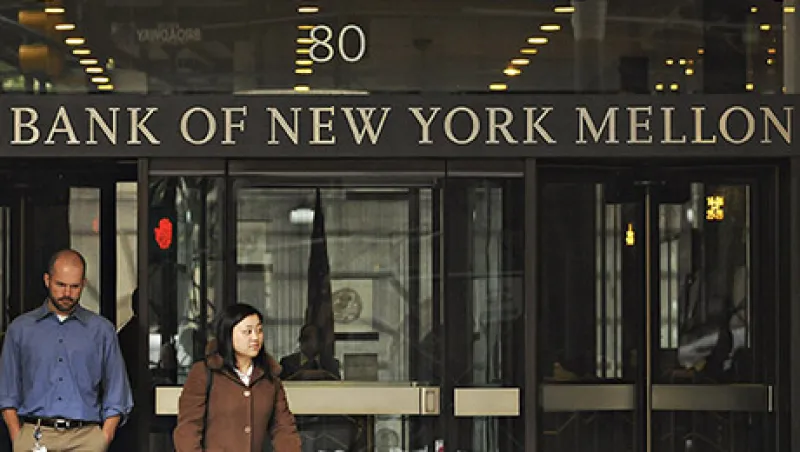When is $714 million not a lot of money? When a bank can pay that sum to settle fraud charges without hurting its underlying business.
Bank of New York Mellon Corp. agreed in March to pay that amount to settle a pair of government lawsuits alleging that it fraudulently executed foreign exchange transactions by not giving clients the best rates available at the time of their trades. Although a significant sum, the figure looks smaller in context. The New York State Office of the Attorney General, which sued the bank along with the U.S. Justice Department, accused BNY Mellon of earning $2 billion over more than ten years from the alleged fraud. The settlement resolved those complaints as well as separate investigations by the Securities and Exchange Commission and the U.S. Department of Labor.
As is typical in many such settlements, BNY Mellon says it did not admit to fraud in its settlement. The bank did acknowledge engaging in some of the practices alleged by the authorities, however, and agreed to get rid of some employees involved in forex trading and to increase disclosures.
Given that some portion of that $714 million is likely tax deductible, legal experts say the deal seems like a bargain. “The conduct here is very, very troublesome,” says Michael Greenberger, a professor at the University of Maryland School of Law and former director of Trading and Markets at the Commodity Futures Trading Commission. “This is a slap on the wrist.”
BNY Mellon’s foreign exchange business has been on a tear so far this year, apparently aided by volatility in the currency markets. On April 22 the bank reported that foreign exchange and other trading revenue jumped 68 percent in the first quarter of 2015 from a year earlier, to $229 million.
The settlement is just the latest effort to clean up the foreign exchange market. In November 2014 European and U.S. regulators fined six global banks a total of $4.3 billion for conspiring to manipulate foreign exchange rates to boost their profits.
BNY Mellon is the oldest bank in the U.S., and with assets of $28.5 trillion under custody or administration, it plays a role in settling trillions of dollars worth of trades on behalf of asset managers, pension funds and other institutional investors.
There are two main ways for clients to convert currencies with BNY Mellon: negotiating directly with the bank’s trading desks or using its standing instruction service, or SI in Wall Street argot. With SI, BNY Mellon claimed to be automatically providing the best possible execution at the time of the trade. Instead, the complaints alleged, BNY Mellon waited until near the end of the trading day. If the client was selling, the bank gave it the day’s lowest price or close to it. If the client was buying, it got the day’s highest price or close to it.
The tactics boosted BNY Mellon’s spread on client trades, and hence its profits. In 2009 the SI service accounted for about 12 percent of the bank’s forex trading volume and 69 percent of the profits, according to the Justice Department complaint. Negotiated forex trades, by contrast, accounted for 88 percent of volume and just 31 percent of profits.
The $714 million is to be divvied up among plaintiffs, victims and the government itself. Who were the victims? A document attached to an amended Justice Department complaint lists the largest SI clients over four years, from 2007 through 2010. ABN AMRO generated the greatest spread for BNY Mellon in 2007 and 2008, with $15.8 million and $28.4 million, respectively. The Florida Retirement System topped the list in 2009 with $13.5 million. And Fidelity Investments’ mutual fund division was first in 2010, with $17.2 million.
Universities, insurers and other banks made the roster too, as did a group of sovereign wealth funds, as detailed on Institutional Investor’s Sovereign Wealth Center. Among BNY Mellon’s top sovereign wealth fund clients were the Alaska Permanent Fund Corp., the Abu Dhabi Investment Authority and the Kuwait Investment Authority. The total spreads generated typically amounted to barely a rounding error compared with the billions of dollars that these clients had under management. Yet some BNY Mellon clients pushed back, complaining about the prices they were getting or other aspects of the SI service.
The Justice Department complaint cited an employee of Capital Group Cos. disputing BNY Mellon’s assertion that it was not entitled to superior interbank rates because the size of its currency trade was below $1 million. “The statement below concerns me as it is NOT TRUE,” the Capital Group employee said, according to the complaint. “There is NO minimum for wholesale interbank prices in forex.”
BlackRock at one point began looking more closely at its SI business with the bank, too, prompting one BNY Mellon employee to worry in late 2009 that the asset management firm would conduct “a full and thorough review of our FX business,” according to the complaint.
BNY Mellon has been rolling out new currency services since the suits were filed, including one using independent third-party prices that reports the time of the trade, according to spokesman Kevin Heine.
The lesson here is that institutional investors need to pay heed to how their accounts are serviced. “This is easily self-policed,” says one former trader. “This case should serve as a warning: Funds, pay attention. This stuff goes on.”
Get more on foreign exchange.







